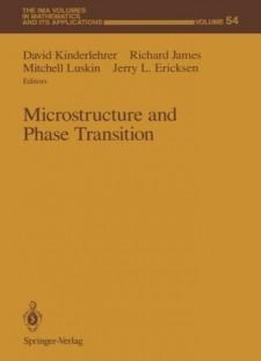
Microstructure And Phase Transition (the Ima Volumes In Mathematics And Its Applications)
by David Kinderlehrer /
2011 / English / DjVu
3 MB Download
This IMA Volume in Mathematics and its Applications MICROSTRUCTURE
AND PHASE TRANSITION is based on the proceedings of a workshop
which was an integral part of the 1990-91 IMA program on "Phase
Transitions and Free Boundaries." We thank R. Fosdick, M.E. Gurtin,
W.-M. Ni and L.A. Peletier for organizing the year-long program
and, especially, D. Kinderlehrer, R. James, M. Luskin and J.
Ericksen for organizing the meeting and editing these proceedings.
We also take this opportunity to thank those agencies whose
financial support made the workshop possible: the Army Research
Office, and the National Science Foun dation. A vner Friedman
Willard Miller. Jr. PREFACE Much of our traditional knowledge of
materials and processes is achievf'd by observa tion and analysis
of small departures from equilibrium. Many materials, especially
modern alloys, ceramics, and their composites, experience not only
larger but more dramatic changes, such as the occurrence of phase
transitions and t.he creation of defect structures, when viewed at
the microscopic scale. How is this observed, how can it be
interpreted, and how does it influence macroscopic behavior? These
are the principle concerns of this volume, which constitutes the
proceedings of an IMA workshop dedicated to these issues.
This IMA Volume in Mathematics and its Applications MICROSTRUCTURE
AND PHASE TRANSITION is based on the proceedings of a workshop
which was an integral part of the 1990-91 IMA program on "Phase
Transitions and Free Boundaries." We thank R. Fosdick, M.E. Gurtin,
W.-M. Ni and L.A. Peletier for organizing the year-long program
and, especially, D. Kinderlehrer, R. James, M. Luskin and J.
Ericksen for organizing the meeting and editing these proceedings.
We also take this opportunity to thank those agencies whose
financial support made the workshop possible: the Army Research
Office, and the National Science Foun dation. A vner Friedman
Willard Miller. Jr. PREFACE Much of our traditional knowledge of
materials and processes is achievf'd by observa tion and analysis
of small departures from equilibrium. Many materials, especially
modern alloys, ceramics, and their composites, experience not only
larger but more dramatic changes, such as the occurrence of phase
transitions and t.he creation of defect structures, when viewed at
the microscopic scale. How is this observed, how can it be
interpreted, and how does it influence macroscopic behavior? These
are the principle concerns of this volume, which constitutes the
proceedings of an IMA workshop dedicated to these issues.











